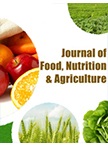Determinants of household food insecurity in Tanzania: A Heckman approach
DOI:
https://doi.org/10.21839/jfna.2024.v7.8939Keywords:
Household food insecurity, Determinants, Heckman approach, TanzaniaAbstract
Household food insecurity is a predominant issue in Tanzania, particularly affecting rural areas where poverty rates are higher. This problem can lead to poor nutritional quality and hinder mental, social, and economic development. The study utilized data from the 2017/18 Tanzania Household Budget Survey to analyse the determinants of food insecurity. Employing the Heckman approach to address the sample selection problem, the study found that household characteristics such as sex of the household head, location, education level, access to credit, household size, marital status, and income significantly reduce the problem of food insecurity among insecure groups. Male-headed, urban location, credit-accessible households and married heads were less food insecure compared to female-headed, rural location and households without access to credit, respectively. In addition, higher household income and education level, as well as smaller household size, positively impacted food expenditure among households. The findings suggest the need for improved credit services, formal education promotion, and targeted food programs, particularly in rural areas, to address household food insecurity effectively in Tanzania.
Downloads
References
Assefa, T., & Abide, E. B. (2023). Determinants of food insecurity in rural households: A case of lemo district, southern Ethiopia. Heliyon, 9(1), E12764. https://doi.org/10.1016/j.heliyon.2022.e12764
Assenga, E. A., & Kayunze, K. A. (2020). Socio-economic and Demographic Determinants of Food Security in Chamwino District, Tanzania. Tanzania Journal of Population Studies and Development, 27(1), 82-105.
Awotide, B. A., Karimov, A. A., & Diagne, A. (2016). Agricultural technology adoption, commercialization and smallholder rice farmers’ welfare in rural Nigeria. Agricultural and Food Economics, 4, 3. https://doi.org/10.1186/s40100-016-0047-8
Bata, U. M., Aliero, H. M., Gatawa, N. M., & Elijah, S. (2018). An Empirical Study of The Determinants of Household Food Consumption Expenditure In Gombe State. International Journal of Humanities and Social Science Invention, 7(9), 36-49.
Bhattacharjee, P., & Sassi, M. (2021). Determinants of the severity of household food insecurity among the slums of Dhaka city, Bangladesh. International Journal of Urban Sustainable Development, 13(2), 233-247. https://doi.org/10.1080/19463138.2020.1868475
Christensen, Z. (2021). Poverty trends: global, regional and national. Development Innitiatives, 1, 3.
Dasgupta, S., & Robinson, E. J. Z. (2022). Impact of COVID-19 on food insecurity using multiple waves of high frequency household surveys. Scientific Reports, 12, 1865. https://doi.org/10.1038/s41598-022-05664-3
FAO, IFAD, & WFP. (2014). The State of Food Insecurity in the World: The multiple dimensions of food security. FAO: Rome.
Feleke, S., Kilmer, R. L., & Gladwin, C. (2016). Determinants of Food Security in Southern Ethiopia. Journal of Gender, Agriculture and Food Security, 1(3), 1-22.
Feyisa, M. N. (2018). Determinants of food insecurity among rural households of South Western Ethiopia. Journal of Development and Agricultural Economics, 10(12), 404-412. https://doi.org/10.5897/jdae2018.0999
Greene, W. H. (2000). Econometric Analysis.(4th Ed). New Jersy: Wiley.
Hashmi, A. A., Sial, M. H., Akram, W., & Hashmi, M. H. (2018). Assessing food insecurity trends and determinants by using mix methods in Pakistan: Evidence from household pooled data (2005-2014). Sarhad Journal of Agriculture, 35(1), 87-101. https://doi.org/10.17582/journal.sja/2019/35.1.87.101
Heckman. (1976). Functional taxonomy of drugs. National Institute on Drug Abuse Research Monograph Series, 5(2), 12-16.
IFAD. (2016). Rural Development Report 2016: Fostering inclusive rural transformation.
Kayunze, K. A., Mwageni, E. A., & Ashimogo, G. C. (2007). Entitlement to Food and Food Insecurity in Rufiji District, Tanzani. Tanzania Journal of Development Studies, 7(2), 47889. https://doi.org/10.4314/tjds.v7i2.47889
Lokosang, L. B., Ramroop, S., & Zewotir, T. (2016). The effect of weakened resilience on food insecurity in protracted crisis: the case of South Sudan. Agriculture & Food Security, 5, 2. https://doi.org/10.1186/s40066-016-0051-y
Mahmood, T., Kumar, R., Ali, T. M., Naeem, N., & Pongpanich, S. (2023). Determinants of the food insecurity at household level in Pakistan: A multilevel model approach. PLoS One, 18(10), e0291343. https://doi.org/10.1371/journal.pone.0291343
Makone, S. M., Basweti, E. A., Menge, D., & Mang’ana, E. M. (2015). Analysis of Coping Mechanisms against Food Shortage Adopted By Households Farm Families in Gusii Highlands, Kenya. IOSR Journal of Agriculture and Veterinary Science, 8(2), 10-13.
Mwanga, M. K. (2019). Demographic and Socio-Economic Determinants Of Household Food Security In Tanzania. International Journal of Advanced Research and Publications, 3(6), 252-258.
NBS. (2020). Household Budget Survey 2017-18 - Tanzania Mainland: Final Report. (Vol. 30, pp. 1-166). National Bureau of statistics. https://doi.org/10.1144/geosci-30-11
Ngongi, A. M., & Urassa, K. (2014). Farm Households Food Production and Households’ Food Security Status: A Case of Kahama District, Tanzania. Tanzania Journal of Agricultural Sciences, 13(2), 40-58.
Rashid, F. N., Sesabo, J. K., Lihawa, R. M., & Mkuna, E. (2024). Determinants of household food expenditure in Tanzania: implications on food security. Agriculture and Food Security, 13, 13. https://doi.org/10.1186/s40066-023-00462-0
Reincke, K., Vilvert, E., Fasse, A., Graef, F., Sieber, S., & Lana, M. A. (2018). Key factors influencing food security of smallholder farmers in Tanzania and the role of cassava as a strategic crop. Food Security, 10, 911-924. https://doi.org/10.1007/s12571-018-0814-3
Safari, J. G., Kirwa, M. K., & Mandara, C. G. (2022). Food insecurity in pastoral communities of Ngorongoro conservation area, Tanzania. Agriculture & Food Security, 11, 36. https://doi.org/10.1186/s40066-022-00374-5
Saruni, P. O., & Mutayoba, V. (2018). Food Security in The Tanzanian Semi-Arid Regions: The Case of Chamwino District the Mwalimu Nyerere Memorial Academy.
Singh, I., Squire, L., & Strauss, J. (1986). Agricultural Household Models: Extensions, Applications, and Policy. Baltimore: Johns Hopkins University Press.
URT. (2017). Comprehensive Food Security and Nutrition Assessment Report the Mfumo wa Uchambuzi wa Uhakika wa Chakula na Lishe (MUCHALI) Partners ii. February.
Wooldridge. (2010). Identifying a particular family humor style: A sociolinguistic discourse analysis. Humor, 16(4), 369-412. https://doi.org/10.1515/humr.2003.021
Worku, C. (2023). Determinants of food security status of household in west Gojjam zone, Ethiopia. Food Science & Nutrition, 11(10), 5959-5966. https://doi.org/10.1002/fsn3.3527






 .
.